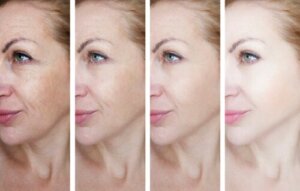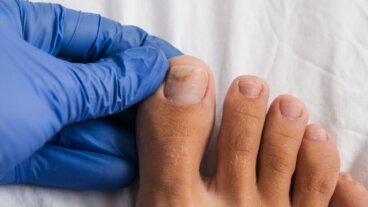Cellular Renewal: The Key to Youthful-Looking Skin


Written and verified by the doctor Mariel Mendoza
Cellular renewal is the concept we need to understand in order to improve the appearance of our skin. Let’s recognize that the skin isn’t only the largest organ of the body, but also a barrier mechanism. So, it’s constantly exposed to various stimuli that directly impact it.
Skin aging is a normal and complex process. It’s associated with physical, chemical, and environmental changes. It will manifest itself in wrinkles, loss of elasticity and tone, and even a rough appearance.
As we age, cell renewal slows down. Therefore, certain behavior can help us to reduce the drastic changes that occur in the skin.
What is cellular renewal?
As we age, the number of cells that have regenerative capacity is reduced. These are the pluripotent stem cells, capable of dividing into more cells or differentiating into specific tissues.
The process affects the whole body, especially the skin.
Various factors play a role in aging, as reported in an article in Cell Transplantation:
- Age
- Degree of sun exposure
- Whether there was contact with cigarette smoke
- Environmental pollution
- Type of diet
Read more about this key topic: Staying Younger Longer: How to Delay Aging
How does cellular renewal occur in the skin?
Various cells are involved in skin cell renewal.
The skin has three layers: the epidermis, dermis, and hypodermis. The first is the outermost and the one that always comes into contact with the environment.
Throughout the epidermis, there’s a continuous loss of keratin. This is a protein that has several functions, including waterproofing and stimulating the development of new skin cells. This loss is followed by a process of desquamation, which we can sometimes see with the naked eye, but sometimes not. The result is a thinner epidermis.
You may have heard the term “exfoliation”. This happens naturally. Keratin sloughs off and washes away dead skin cells that no longer serve a function. When we’re young, there’s cell regeneration and new elements occupy the empty places. However, as we age, we have less and less capacity to replenish what has been lost.
The skin’s regenerative cycle lasts approximately 28 days.
During the night, regenerative activity doubles and in the early morning it reaches its peak, as a 2015 scientific article makes clear. This means that, when sleeping, collagen production (which accounts for up to 75% of the dry weight of the skin) is increased and cell damage is repaired. Therefore, a basic recommendation for youthful skin is to get enough sleep.
Learn more about: Redensification to Prevent Premature Aging
Tips to maintain cellular renewal and look youthful
Youthful skin is what many people seek. This goes beyond aesthetics. What we want is to delay skin aging to preserve the functions that ensure our well-being, such as protection against external agents.
To stimulate cell renewal, it’s generally recommended to do the following:
- Use sunscreen: Ultraviolet (UV) rays can damage our skin. In fact, a major factor in extrinsic skin aging is considered to be exposure to these rays. A classic sign in older adults is the appearance of “sunspots” or solar lentigines, as reported by scientist Tobin. For all these reasons, broad-spectrum sunscreens are a key element of protection that contribute to cell regeneration. The cosmetic industry is working on improvements to these products, trying to enhance their blocking power by adding collagen and keratin to the formulas.
- Consume food with antioxidants: To counteract the harmful effects of aging, the whole body has an antioxidant system. These are substances that block free radicals in cells, preventing them from damaging tissues. Since many antioxidants are vitamins, we can consume them to help the skin. For example, vitamin C and vitamin E.
- Prefer a diet with the following food: Some food, in addition to providing vitamins, has been shown to impact skin health, as stated in an article in the scientific journal Nutrients. It would be good for your skin cell renewal if you increase your intake of food products with taurine, a-tocopherol, niacinamide, riboflavin, zinc, and manganese. Simply put, this means increasing your intake of fruits and vegetables.
Include new ingredients in your skincare routine
On the other hand, cellular renewal improves when we include certain products in our cosmetics:
- Retinoids: These are elements chemically similar to vitamin A. Numerous studies have documented the efficacy of retinoic acid in repairing photodamaged skin clinically, histologically and molecularly, as detailed by Kong et al. (2016). Retinol produces significant reductions in fine wrinkles, mottled hyperpigmentation, and roughness.
- Bakuchiol: This is a new ingredient that became fashionable in cosmetic skin care products. Studies claim that it has similar efficacy to over-the-counter vitamin A derivatives. Topical treatment with 0.5% bakuchiol would improve the aging process of the skin. It’s a good recommendation, in case retinoids aren’t well tolerated.
- Alpha and beta hydroxy acids (AHA and BHA): These products can be applied once or twice daily to even out skin pigmentation and improve texture.
- Copper peptides: Another ingredient that has become popular for facial creams. According to research, it would improve facial tone, clarity, and overall appearance of both the face and hair.
Other treatments
Some treatments are experimental, are recommended for other situations, and have effects on the skin or directly result in an aesthetic approach to skin aging. They’re listed here as options to promote cell renewal, but you should consult a doctor before starting them.
- Hormone therapy: Hormone replacement therapy (HRT) for menopause has been a topic of great interest when analyzing its effects on the skin. In theory, it would improve hydration and elasticity by promoting collagen production. However, these aren’t its main benefits.
- Stem cells: Stem cell transplantation is a promising therapy to address skin aging. In particular, experiments are underway with adipose tissue transplantation for facial rejuvenation.
- Laser: Thermal energy can be used to selectively remove a pigmented target or for wrinkle reduction. After treatment, the skin may be stimulated to make more collagen and repair the area treated by the laser.
- Cosmetic surgery is the most invasive treatment approach for wrinkles. Cosmetic surgery removes portions of the skin or fills in subdermal tissue to give the appearance of smoothing. These procedures are often combined with topical sessions of creams, lasers, and chemical peels to refine results and encourage “more natural” cell turnover.
The key to cellular renewal is preventing damage
The changes that occur with aging are manifold. However, there are a wide range of options available that we can employ to achieve youthful skin for years to come.
The main recommendations remain basic: protect yourself from UV exposure, get plenty of sleep, and eat right. Consult with a dermatologist about which creams and cosmetic products can complement your lifestyle to make younger skin a reality.
All cited sources were thoroughly reviewed by our team to ensure their quality, reliability, currency, and validity. The bibliography of this article was considered reliable and of academic or scientific accuracy.
- Cao, C., Xiao, Z., Wu, Y., & Ge, C. (2020). Diet and skin aging—From the perspective of food nutrition. Nutrients, 12(3), 870. https://www.mdpi.com/672752
- Chaudhuri, R. K., & Bojanowski, K. (2014). Bakuchiol: a retinol‐like functional compound revealed by gene expression profiling and clinically proven to have anti‐aging effects. International journal of cosmetic science, 36(3), 221-230. https://onlinelibrary.wiley.com/doi/abs/10.1111/ics.12117
- Cribier, B. (2021). Histología de la piel normal y lesiones histopatológicas elementales. EMC-Dermatología, 55(2), 1-14. https://www.sciencedirect.com/science/article/pii/S1761289621451393
- Kong, R., Cui, Y., Fisher, G. J., Wang, X., Chen, Y., Schneider, L. M., & Majmudar, G. (2016). A comparative study of the effects of retinol and retinoic acid on histological, molecular, and clinical properties of human skin. Journal of cosmetic dermatology, 15(1), 49-57. https://onlinelibrary.wiley.com/doi/abs/10.1111/jocd.12193
- Matyasovsky, J., Sedliacik, J., Jurkovic, P., & Duchovic, P. (2014). Collagen and keratin colloid systems with a multifunctional effect for cosmetic and technical applications. Journal of the American Leather Chemists Association, 109(09), 284-295. https://journals.uc.edu/index.php/JALCA/article/view/3561
- Pickart, L., & Margolina, A. (2018). Regenerative and protective actions of the GHK-Cu peptide in the light of the new gene data. International journal of molecular sciences, 19(7), 1987. https://www.mdpi.com/313588
- Riahi, R. R., Bush, A. E., & Cohen, P. R. (2016). Topical retinoids: therapeutic mechanisms in the treatment of photodamaged skin. American journal of clinical dermatology, 17, 265-276. https://link.springer.com/article/10.1007/s40257-016-0185-5
- Surowiecka, A., & Strużyna, J. (2022). Adipose-Derived Stem Cells for Facial Rejuvenation. Journal of Personalized Medicine, 12(1), 117. https://www.mdpi.com/1451862
- Takeo, M., Lee, W., & Ito, M. (2015). Wound healing and skin regeneration. Cold Spring Harbor perspectives in medicine, 5(1), a023267. https://doi.org/10.1101/cshperspect.a023267
- Tobin, D. J. (2017). Introduction to skin aging. Journal of tissue viability, 26(1), 37-46. https://www.sciencedirect.com/science/article/pii/S0965206X16000280
- Zhang, S., & Duan, E. (2018). Fighting against Skin Aging: The Way from Bench to Bedside. Cell transplantation, 27(5), 729–738. https://doi.org/10.1177/0963689717725755
This text is provided for informational purposes only and does not replace consultation with a professional. If in doubt, consult your specialist.








